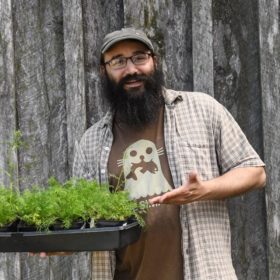 The Door County Seed Library is pleased to announce a free seed saving workshop on Thursday, September 19 from 6 – 8 p.m. at Crossroads at Big Creek. The workshop will be led by author and seed activist Ben Cohen from Small House Farm in Michigan, who will discuss the best methods for planting, saving, and sharing seeds. This is a free community event and no registration is necessary. The Door County Seed Library is a collaborative partnership of the Door County Master Gardeners, Sturgeon Bay Branch of the Door County Library, UW-Extension, Wild Ones of Door Peninsula, and The Community’s Garden.
The Door County Seed Library is pleased to announce a free seed saving workshop on Thursday, September 19 from 6 – 8 p.m. at Crossroads at Big Creek. The workshop will be led by author and seed activist Ben Cohen from Small House Farm in Michigan, who will discuss the best methods for planting, saving, and sharing seeds. This is a free community event and no registration is necessary. The Door County Seed Library is a collaborative partnership of the Door County Master Gardeners, Sturgeon Bay Branch of the Door County Library, UW-Extension, Wild Ones of Door Peninsula, and The Community’s Garden.
Saving seeds is an exacting and sometimes complicated process. So how does nature do it? Actually, plants have countless mechanisms for dispersing and “saving” seeds. If a plant is not extinct, its method work.
For seed dispersal, it’s hard to imagine a method that works better than that of the dandelions. In dry weather, the airborne seeds (attached to their tiny parachutes) can ride the breezes for as far as a hundred miles and stay aloft indefinitely. But when the humidity exceeds 70%, the seeds drop out of the sky.
High humidity usually precedes rain. Perfect! The seeds drop at just the right time to germinate which they can do throughout the growing season. An estimated 25% of dandelion seeds germinate right away, especially on warm days and when they land in sunny, disturbed soil. (Some researchers suspect that dandelions may be programmed in such a way that they do not germinate all at once. If this is true, it would have enormous survival benefits because dandelion seeds stay viable for decades.)
After they germinate, the young dandelion plants first develop healthy root systems that are able to survive winter. Even though we often don’t notice the dandelions that sprout in fall, they usually are the first plants to bloom in the spring.
The fall flowers—goldenrod, asters, sunflowers—that are blooming right now…how are their seeds saved? Well, once a flower is fertilized it wilts and seeds form. Some seeds such as those of milkweeds, have parachutes like dandelions and are spread by the wind. However, they are programmed in such a way that they must go through a period of cold and damp before they germinate.
Many prairie plants hold their seeds through fall, but as winter progresses, the seeds blow or drop or are shaken loose by foraging birds. They fall the surface of the snow. Because they are dark, seed absorb the feeble heat of the winter Sun, making them warm enough to melt their way through the snow to the ground. There, the freeze/thaw cycle of late winter moistens and plants the seeds.
The forest wildflowers of spring have even more elaborate mechanisms. A number of woodland wildflower seeds are harvested and saved by ants. Researchers have documented ants lugging seeds as far as 70 yards from a parent plant. No, they are not doing good deeds in order to earn their right to live on earth. Ants are greedy.
Seeds of these spring wildflowers have little lumps filled with oils and sometimes sugar. These delicacies must be irresistible, so the ants haul them home and down into their nest tunnels. But when the time comes to eat, the ants find that the actual seeds have extremely hard shells. …too hard for ants to chew….so the tidy creatures discard the wildflower seeds in one of their underground tunnels. In other words, they save and plant the seeds.
Before the Seed Saving Workshop, at 5:30 the volunteers who tend the Heritage Garden at the Crossroads will be conducting tours. This garden has been planted with seeds that were available between 1890 and 1910 and have been saved through the generations

